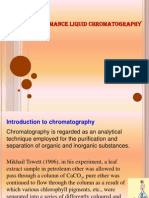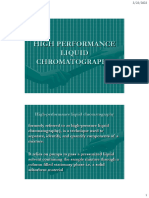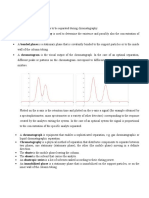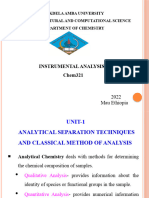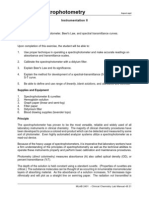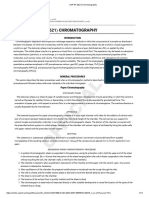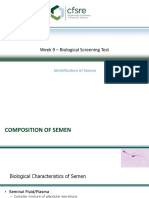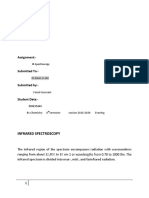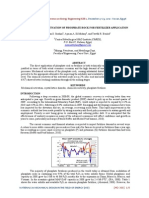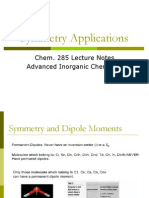9080 Et Et
9080 Et Et
Uploaded by
partikCopyright:
Available Formats
9080 Et Et
9080 Et Et
Uploaded by
partikOriginal Title
Copyright
Available Formats
Share this document
Did you find this document useful?
Is this content inappropriate?
Copyright:
Available Formats
9080 Et Et
9080 Et Et
Uploaded by
partikCopyright:
Available Formats
SUBJECT FORENSIC SCIENCE
Paper No. and Title PAPER No.9: Drugs of Abuse
MODULE No.22: Instrumental Methods of Analysis of
Module No. and Title
Drugs
Module Tag FSC_P9_M22
FORENSIC SCIENCE PAPER No.9: Drugs of Abuse
MODULE No.22: Instrumental Methods of Analysis of
Drugs
TABLE OF CONTENTS
1. Learning Outcomes
2. High performance Thin Layer Chromatography
3. Gas Chromatography
4. High Performance Liquid Chromatography
5. UV-VIS spectrometry
6. Infra-Red Spectrophotometry
7. Summary
FORENSIC SCIENCE PAPER No.9: Drugs of Abuse
MODULE No.22: Instrumental Methods of Analysis of
Drugs
1. Learning Outcomes
After studying this module, you will be able to know about:
The important Instrumental Techniques for Drug Analysis
The basics of instrumentation
Drug detection by the specific instrumental technique
2. Introduction to High Performance Thin Layer Chromatography
Principle:
In Thin Layer Chromatography (TLC), constituents of a mixture are separated on thin
uniform surface of solid stationary phase (usually Silica) coated on glass/ aluminum/
plastic plate with the help of moving liquid phase. The mobile liquid phase migrates
(ascends) on solid stationary phase by capillary action carrying the different analyte
molecules of a mixture with different speed depending upon their affinity for stationary
phase. In this process, the constituents (analytes) are separated into fractions. After
development of the chromatogram to a certain distance, the Thin Layer Chromatography
plate is removed and mobile phase is evaporated. The track is scanned in a Densitometer
with a light beam in visible or ultraviolet range of the spectrum. Depending upon the
mode of scanning absorbance or fluorescence is measured by diffuse reflectance.
FORENSIC SCIENCE PAPER No.9: Drugs of Abuse
MODULE No.22: Instrumental Methods of Analysis of
Drugs
Equipment of HPTLC:
A. TLC Plates:
Normal phase TLC plates:
In normal phase TLC plate, analytes are primarily isolated as per their polarity and their
solubility for the mobile phase. The chemical constituents in the normal phase TLC plates
are of silica gel with gypsum as a binder to increase the mechanical strength of silica gel.
Reversed phase TLC plates:
Because of the interest in reversed phase plates HPLC, pre-coated reverse phase TLC
plates are available with C18, C8, C2 and phenyl groups chemically bonded on to a silica
support to produce stationary phases.
HPTLC Plates:
HPTLC plates have the layer of stationary phase particles of size 3-7 m. with a
thickness of 20mm. Due to insignificant size of the particles and higher surface area,
HPTLC plates show less lateral spreading and hence the concentration in the spot is
higher, which makes the analyte easy to identify and increase the sensitivity.
B. Sample Application:
Sample is applied either manually using capillary tube in the form of spots or automatic
TLC sampler in the form of narrow bands using spray technique. Narrow bands at
starting zone confirm the maximum resolution.
C. Development Chamber:
After application of sample plate is settled in even bottommost, Twin trough horizontal or
automatic developing chamber.
FORENSIC SCIENCE PAPER No.9: Drugs of Abuse
MODULE No.22: Instrumental Methods of Analysis of
Drugs
D. Automated multiple developments (AMD):
The advantage of multiple developments is that it is helpful in improving the separation
of analytes with low Rf values. In the AMD procedure fractions are focused into narrow
bands with characteristic peak width of about 1 mm so that on available separation
distance of 80mm on a HPTLC plate, up to 40 constituents can be resolved (i.e., with
baseline separation).
E. Densitometer (Scanner):
For densitometry assessment of a HPTLC chromatogram, the path is scanned with the
help of beam of light in the form of a slit which is selectable in both width and length.
Diffusely reflected light is measured with photo sensor (photo multiplier).
Applications of HPTLC
Qualitative Analysis:
1. Rf values are estimated and matched with the control samples. To avoid the use
of decimals in these values, it is multiplied by 100 and the values are then
referred to as hRf.
2. In-situ spectra (Absorbance Vs. Wavelength) of the analyte and standard
reference material are recorded and compared.
Quantitative Analysis:
For quantification, the dissimilarity in optical signal from the sample frees circumstantial
and that from a sample zone (fractions) correlated with the amount of the respective
fractions of calibration standards chromatographed on that plate. Densitometry scanning
measurement can be made in absorbance or fluorescence mode by measuring diffusely
reflected light. Alternatively to classical densitometry, planar chromatography can be
evaluated by video technology. Additional operations such as pre and post
chromatographic dramatizations can be performed as required.
FORENSIC SCIENCE PAPER No.9: Drugs of Abuse
MODULE No.22: Instrumental Methods of Analysis of
Drugs
For quantitative analysis in absorbance mode, Beer-Lambert's Law is applied.
A or (log I/I₀) = abc
,
Where,
a = absorption coefficient,
b = path length
c = concentration
A = Absorbance
3. Gas Chromatography
Gas chromatography - precisely gas-liquid chromatography - includes a tester being
evaporated and inserted onto the head of the chromatographic column. The tester is
passed over the column with the movement of inert, gaseous mobile phase. The column
comprises of the stationary phase (liquid) that is adsorbed by the inert solid onto its
surface.
Instrumental components
Carrier gas
The gas that is used as a carrier must be chemically inert and mainly comprise of gases
such as N, He, Ar and CO2. The selection of carrier gas is basically reliant on the form of
detector, which is used. The carrier gas system also comprises a molecular sieve to
eliminate water and other contaminations.
Sample injection port
The most customary injection technique is where a micro syringe is used to insert tester
by a rubber septum into a flash vaporizer port at the head of the column. The temperature
of the tester port is generally about 50°C higher than the boiling point of the least volatile
component of the sample. In case of packed columns the sample size varies from 1/10 –
1/20 microliters. Capillary columns, on the other hand, require much less sample,
characteristically around 10-3 ml. For capillary GC, split/split less injection is used.
The injector comprises a heated chamber covering a glass liner into which the sample is
inserted by the septum. The carrier gas goes in the chamber and can get out by three ways
(when the injector is in split mode).
FORENSIC SCIENCE PAPER No.9: Drugs of Abuse
MODULE No.22: Instrumental Methods of Analysis of
Drugs
The sample evaporates to form a combination of carrier gas, vaporized solvent and
vaporized solutes. An amount of this combination passes onto the column, but most
departure from the split outlet. The septum purge outlet stops septum bleed constituents
from inflowing the column.
Columns
There are two usual kinds of column, packed and capillary (also called as open tubular).
Packed columns are formed by using materials that are inert, finely divided having solid
support component comprising of diatomaceous earth covered with liquid stationary
phase. The length of these columns varies from 1.5 - 10m and the internal diameter of the
column varies from 2 - 4mm.
Capillary columns have an internal diameter of a few tenths of a millimeter. They can be
one of two kinds; Wall-Coated Open Tubular (WCOT) or Support-Coated Open Tubular
(SCOT). WCOT columns contain a capillary tube wherein the walls are covered with a
stationary phase that is liquid. In support-coated columns, the inside of the capillary tube
is coated with a thin film of diatomaceous earth that acts as a support material and the
stationary phase is adsorbed on it. These types of column are usually less effective than
the wall coated open tubular columns. Both types of capillary column are more efficient
than packed columns.
In 1979, a new type of WCOT column was devised - the Fused Silica Open Tubular
(FSOT) column; these have much thinner walls than the glass capillary columns, and in
this strength is provided by the polyimide coating. These columns are flexible and can be
wound into coils. They have the advantages of physical strength, flexibility and low
reactivity.
FORENSIC SCIENCE PAPER No.9: Drugs of Abuse
MODULE No.22: Instrumental Methods of Analysis of
Drugs
Column temperature:
For precise work, column temperature must be controlled within tenths of a degree. The
boiling point of the sample determines the optimum column temperature. As a rule of
thumb, a temperature slightly above the average boiling point of the sample results in an
elution time of 2 - 30 minutes. Good resolution can be obtained by increasing the elution
time but having minimum temperature. If a sample has a wide boiling range, then
temperature programming can be useful. The column temperature is increased (either
continuously or in steps) as separation proceeds.
Detectors:
There are many detectors, which can be used in gas chromatography. Various kinds of
selectivity can be obtained by using different detectors. A non-selective detector retorts to
all compounds apart from the carrier gas. A selective detector responds to a variety of
compounds with a common physical or chemical property and a specific detector
responds to a single chemical compound. These can be classified into concentration
dependent and mass flow dependant detectors. Concentration of solute is directly related
to the signal given by the concentration dependent detector and hence the sample is not
generally destroyed. Dilution with make-up gas will lower the detectors response. The
signal from the mass flow dependent detectors is related with the solute molecules rate at
which they enter the detector and thus in this the sample gets destroyed. The response of
a mass flow dependent detector is unaffected by make-up gas.
FORENSIC SCIENCE PAPER No.9: Drugs of Abuse
MODULE No.22: Instrumental Methods of Analysis of
Drugs
Have a look at this tabular summary of common GC detectors:
Detectable Dynamic
Detector Type Support gases Selectivity
Limit range
Flame ionization Hydrogen Most organic
Mass flow 100 pg 107
(FID) and air compounds
Thermal conductivity
Concentration Reference Universal 1 ng 107
(TCD)
Halides, nitrates,
Electron capture nitriles, peroxides,
Concentration Make-up 50 fg 105
(ECD) anhydrides,
organometallics
Hydrogen Nitrogen,
Nitrogen-phosphorus Mass flow 10 pg 106
and air phosphorus
Sulphur,
Hydrogen phosphorus, tin,
Flame photometric and boron, arsenic,
Mass flow 100 pg 103
(FPD) Air, possibly germanium,
oxygen selenium,
chromium
Aliphatic,
aromatics,
ketones, esters,
aldehydes,
Photo-ionization
Concentration Make-up amines, 2 pg 107
(PID)
heterocyclic,
organosulphur,
some
organometallics
Halide, nitrogen,
Hall electrolytic Hydrogen,
Mass flow nitrosoamine,
conductivity oxygen
Sulphur
FORENSIC SCIENCE PAPER No.9: Drugs of Abuse
MODULE No.22: Instrumental Methods of Analysis of
Drugs
The effluent from the column is mixed with hydrogen and air, and ignited. Organic
compounds form electrons and ions when introduced to flame and that also results in
conduction of electricity. The collector electrode is situated just above the flame thereby
resulting in the production of large electrical potential at the burner tip. FIDs are mass
sensitive rather than concentration sensitive; hence the detector’s response is not affected
by the flow rate of mobile phase. The Flame Ionization Detector is useful for the study of
organic compounds due to its high sensitivity, low noise and large linear response range.
It is also robust and easy to use, but unfortunately, it destroys the sample.
4. High Performance Liquid Chromatography
HPLC instrumentation includes a pump, injector, column, detector and recorder or data
system. The heart of the system is the column where separation occurs. A high pressure
pump is needed so as to move the mobile phase through the column as the stationary
phase comprises of micrometer size porous particles. The chromatographic process
begins by injecting the solute onto the top of the column. Separation of components
occurs as the analytes and mobile phase are pumped through the column. Eventually,
each component elutes from the column as a narrow band (or peak) on the recorder.
Detection of the eluting components is important, and this can be either selective or
universal, depending upon the detector used. The response of the detector to each
component is displayed on a chart recorder or computer screen. To collect, store and
analyze the chromatographic data, computers, integrators, and other data processing
equipment are frequently used.
Mobile phase reservoir & filtering
The most common type of solvent reservoir is a glass bottle. So as to remove the
dissolved air purge gas or helium is used and Teflon tubing and filters are employed to
connect it to the pump inlet.
Solvent delivery system
High-pressure pumps are generally used to move solvents by force through the packed
stationary phase beds. Flow rate stability is an important pump feature. An added feature
found on the more elaborate pumps is external electronic control. Although it adds to the
expense of the pump, external electronic control is a very desirable feature, when
automation or electronically controlled gradients are to be run. It is desirable to have an
integrated degassing system, either helium purging, or vacuum degassing.
FORENSIC SCIENCE PAPER No.9: Drugs of Abuse
MODULE No.22: Instrumental Methods of Analysis of
Drugs
Columns
Typical LC columns are 10, 15 and 25 cm in length and are fitted with extremely small
diameter (3, 5 or 10 mm) particles. The inner diameter of the column is generally 4-4.6
mm and this is considered as the suitable condition for speed, mobile phase consumption,
and resolution and sample capacity. However, if pure substances are to be collected
(preparative scale), larger diameter columns may be needed.
Detectors
In case of liquid chromatographic system optical detectors are usually employed. These
detectors pass a beam of light through the flowing column effluent as it passes through a
low volume (~ 10 ml) flow cell. The variations in light intensity caused by UV
absorption, fluorescence emission, or change in refractive index (depending on the type
of detector used) from the sample components passing through the cell, are monitored as
changes in the output voltage.
These voltage changes are recorded on a strip chart recorder and frequently are fed into
an integrator or computer to provide retention time and peak area data.
The most commonly used detector in LC is the ultraviolet absorption detector. This
variable wavelength detector is adept at monitoring from 190 to 460-600 nm and hence is
suitable for detection of samples.
Other detectors in common use include: Refractive index (RI), Fluorescence (FL),
electrochemical (EC) conductivity, Photo diode array and mass-spectrometric (MS)
detectors. The RI detector is universal but also the less sensitive one. FL and EC
detectors are quite sensitive (up to 10-15 moles) but also quite selective. The MS detector
is the most powerful one for the identification.
Injectors
Sample introduction can be accomplished manually or by auto samplers. In liquid
chromatography, liquid samples may be injected directly and solid samples need to be
dissolved in an appropriate solvent, preferably mobile phase. It is essential to remove
particles from the sample by filtering, or centrifuging since continuous injections of
particulate material will eventually cause blockage of injection devices or columns.
FORENSIC SCIENCE PAPER No.9: Drugs of Abuse
MODULE No.22: Instrumental Methods of Analysis of
Drugs
Data station
The data station consists of a PC, an integrator/printer that in addition to revealing the
chromatograms stores and monitors various parameters related to the system. The PC
selected should be compatible to the main system.
5. UV-VIS Spectroscopy
Absorption spectrometry in the UV-VIS regions is considered to be one of the oldest
physical methods used for quantitative analysis and structural analysis.
The law of absorption of radiant energy with which the analyst is concerned involves the
relationship between the magnitude of absorption and the quantity of absorbing material
present in solution. These laws are applicable to absorption of energy in any region of the
spectrum.
Bouguer – Lambert’s Law:
It states that the proportion of light absorbed by a transparent medium is independent of
the intensity of the incident light, and that each successive layer of the medium absorbs
an equal fraction of the light passing through it. This can be expressed mathematically:
I = Io x e-t or loge (Io/I) = t or log (Io/I) = Kl
Where,
Io – Intensity of the incident light
I – Intensity of the transmitted light
t – Thickness of the layer in centimeters
– Absorption coefficient of the medium
K – Constant depending only on the medium examined and is known as
extinction coefficient.
FORENSIC SCIENCE PAPER No.9: Drugs of Abuse
MODULE No.22: Instrumental Methods of Analysis of
Drugs
Beer’s law:
The absorption coefficients and K contain no concentration factor and Beer’s law deals
with this variable. According to this law the light absorbed is proportional to the number
of molecules of absorbing substance through which the light is passed. If the absorbing
substance is dissolved in a transparent medium, the absorption of the solution will be
proportional to its molecular concentration.
Beer – Lambert’s law:
The combined law may be expressed as
Log (Io/I) = cl
Where
- Molecular extinction coefficient
C - Concentration in gram moles per liter.
The validity of the combined law should be tested for each system, which is being
quantitatively investigated. It is simply necessary to prepare a series of known
concentrations of the substance being measured and determine the absorbance at a
particular wavelength. The values may be plotted against concentration or the molecular
extinction coefficient may be attributed to a deviation from Beer’s law. Beer’s law is a
limiting law for dilute solutions.
QUALITATIVE APPLICATIONS
Specific identification of a compound can rarely be made on the basis of spectral
evidence alone. Often the spectrum serves as confirmatory evidence of identity, in
support of other analytical data. Spectra are recorded in aqueous acidic, basic, and in
ethanolic or methanolic solution. The wavelengths of the principal peaks and the
corresponding absorptivity values are noted for each solvent system. By comparison
with data tabulated in ascending wavelength order a number of compounds with
absorbing properties.
Spectral shifts are among the most useful diagnostic features in drug molecules
possessing ion groups. A marked bathochromic shift in alkaline solution is observed not
only for most of the phenolic drugs such as the phenolic estrogens, but also in the case of
hydroxyl pyridines, ketones, benzodiazepines, pyridines, and nitro-compounds.
FORENSIC SCIENCE PAPER No.9: Drugs of Abuse
MODULE No.22: Instrumental Methods of Analysis of
Drugs
6. Infra- Red Spectrophotometry
Infra-red Spectrophotometry is the study of the reflected, absorbed, or transmitted radiant
energy in that region of the electromagnetic spectrum from wavelength () 0.8 to 500m.
A more commonly used measurement than wavelength is the frequency (the number of
waves per unit length). This is expressed in wave numbers (cm-1). The infrared spectrum
is usually divided into three regions 12,500 to 4000 cm-1 (0.8 to 2.5 m) (near infra-red),
4000 to 400 cm-1 (2.5 to 25m) (mid infra-red) and 400 to 20 cm-1 (25 to 500 m) (far
infra-red). Only the mid infrared region (usually referred to simply as ‘infra-red’) is
considered here because it is the region, which is widely used in the analysis of drugs and
pesticides.
When a molecule is subjected to infra-red radiation, transitions take place between
rotational and vibrational energy levels in the ground electronic state. These transitions
give rise to an absorption spectrum characteristic of the compound. This is in contrast to
ultraviolet radiation, which also causes transitions between rotational and vibrational
energy levels, but because of its greater energy these transitions occur at higher energy
states. In the infra-red, absorption occurs only where a change of the dipole moment of a
molecule can take place. This means that diatomic molecules without dipoles, such as
hydrogen, nitrogen and oxygen, do not absorb in the infra-red. Total symmetry about an
absorption band will eliminate certain absorptions, e.g. the symmetrical ethane molecule
gives no-carbon-carbon stretching absorption bands.
Three main types of absorption occur, namely fundamental, overtone, and combination.
Fundamental bands are the primary absorption bands for each mode of vibration,
overtone bands occur at multiples of the fundamental band wavelength, and combination
bands occur at wavelengths which are the sum or difference of two or more fundamental
bands. Overtone and combination bands are usually much weaker than fundamental
bands.
Particular bonds or functional groups in a molecule have specific absorption bands at
given wave numbers. Changes in the wave number of a band have been correlated with
changes in either the structural environment or the physical state of the molecule. These
correlations form the basis of qualitative analytical work in infra-red Spectrophotometry.
However, many bands in the complex region from 1600 to 400 cm-1, which is usually
referred to as the ‘fingerprint region’, are still of unconfirmed origin. A proportion of the
bands is characteristic of the molecule as a whole and cannot be assigned to particular
functional groups.
FORENSIC SCIENCE PAPER No.9: Drugs of Abuse
MODULE No.22: Instrumental Methods of Analysis of
Drugs
7. Summary
HPTLC is advanced technology which is fundamentally based on TLC principle but
gives better result than TLC method.
HPTLC results come in the form of chromatograms which can be helpful in
qualitative and quantitative examination.
Gas Chromatography is the basic technique for volatile drugs and can used with
many detectors which can be selected on the basis of sample which has to be
analyzed.
UV-VIS spectroscopy gives quantitative results of the investigated material.
Infra-red Spectrophotometry is also known as fingerprint of molecules and gives
very accurate results for pesticides and drugs.
FORENSIC SCIENCE PAPER No.9: Drugs of Abuse
MODULE No.22: Instrumental Methods of Analysis of
Drugs
You might also like
- Notes ChromatographyDocument4 pagesNotes ChromatographySrinivasa Rao AmbatiNo ratings yet
- Physical Tests / Á621ñ Chromatography 1Document10 pagesPhysical Tests / Á621ñ Chromatography 1Villalpando D. PabloNo ratings yet
- HPTLCDocument11 pagesHPTLCSahid AhmedNo ratings yet
- ChromatographyDocument6 pagesChromatographyJyoti SharmaNo ratings yet
- Instrumental Techniques: ChromatographyDocument7 pagesInstrumental Techniques: ChromatographyAndrés Felipe Bahamón MonjeNo ratings yet
- Advanced Analytical Chemistry - Chromatography 20231205Document80 pagesAdvanced Analytical Chemistry - Chromatography 20231205paulrwarakabije000No ratings yet
- ChromatographyDocument18 pagesChromatographyNishamolKSNo ratings yet
- Ca 3 ImaDocument5 pagesCa 3 ImaSuvankar PalNo ratings yet
- Usp 621 PDFDocument7 pagesUsp 621 PDFnur_yusri_1No ratings yet
- ChromatographyDocument10 pagesChromatographyBioclass BitesNo ratings yet
- USP 621 Chromatography 1698974779Document19 pagesUSP 621 Chromatography 1698974779Nimsi levíNo ratings yet
- Basic Analytical ChemistryDocument23 pagesBasic Analytical Chemistrysubhan_fsc100% (1)
- Apa 5Document24 pagesApa 5athira30janNo ratings yet
- First Supplement To USP 40-NF 35 PDFDocument12 pagesFirst Supplement To USP 40-NF 35 PDFDwi Mega PratiwiNo ratings yet
- UPLCDocument33 pagesUPLCrat001No ratings yet
- Drugs and Poisons in Humans MethodeDocument11 pagesDrugs and Poisons in Humans MethodeFaeyza Abimanyu SNo ratings yet
- Assignment 1 1Document40 pagesAssignment 1 1Thalari Surya ujwalNo ratings yet
- Analytical ChemistryDocument11 pagesAnalytical Chemistrypalwashasahar624No ratings yet
- SCH 2304 Set 3 Notes Separation TechniquesDocument24 pagesSCH 2304 Set 3 Notes Separation TechniquesKorir DennisNo ratings yet
- 1526972909P9M15 EtDocument14 pages1526972909P9M15 EtKaFiAliMirzaNo ratings yet
- High-Performance Liquid ChromatographyDocument5 pagesHigh-Performance Liquid ChromatographyYulia PrimasariNo ratings yet
- Experiment 2 TLCDocument6 pagesExperiment 2 TLCAnonymous 75TDy2yNo ratings yet
- Analytical AssignmentDocument7 pagesAnalytical AssignmentgeduenNo ratings yet
- Chromatography PharmacyDocument41 pagesChromatography PharmacyfarisaNo ratings yet
- Assignment 1Document40 pagesAssignment 1Thalari Surya ujwalNo ratings yet
- Biochem TutDocument3 pagesBiochem TutSanjeshni KumarNo ratings yet
- Department of Electronics and Instrumentation Engineering Analytical Instruments Two Marks Questions and Answers Unit-IDocument10 pagesDepartment of Electronics and Instrumentation Engineering Analytical Instruments Two Marks Questions and Answers Unit-ISandhiya SNo ratings yet
- Gas ChromatographyDocument25 pagesGas ChromatographyPrabneeshNo ratings yet
- Basic Chromatography - 1 PDFDocument22 pagesBasic Chromatography - 1 PDFriyaNo ratings yet
- UNIT-V Chromatographic MethodsDocument22 pagesUNIT-V Chromatographic MethodsriyaNo ratings yet
- Unit 4 ChromatographyDocument22 pagesUnit 4 Chromatographysam048No ratings yet
- Chromatography TermsDocument23 pagesChromatography TermsJamiel CatapangNo ratings yet
- Guia Cromatografía USP 38Document11 pagesGuia Cromatografía USP 38Carina FloresNo ratings yet
- Instrumental HPLCDocument7 pagesInstrumental HPLCTok WanNo ratings yet
- Instrumental Analysis IDocument151 pagesInstrumental Analysis IYona KelbessaaNo ratings yet
- Basic Analytical Chemistry TrainingDocument23 pagesBasic Analytical Chemistry TrainingFidaa JaafrahNo ratings yet
- Chromatography - WikipediaDocument26 pagesChromatography - WikipediaGeetha AjiNo ratings yet
- Nirav M.SC Molecular ScienceDocument26 pagesNirav M.SC Molecular Sciencepatelnirav121983No ratings yet
- UNIT: SpectrophotometryDocument15 pagesUNIT: SpectrophotometrybiddyusmcNo ratings yet
- Stationary Phase, Which Separates The Analyte To Be Measured From Other MoleculesDocument15 pagesStationary Phase, Which Separates The Analyte To Be Measured From Other MoleculesJatinChadhaNo ratings yet
- HPTLC-PPT FinalDocument24 pagesHPTLC-PPT FinalkbnarkhedeNo ratings yet
- Kajhal PPTCDocument26 pagesKajhal PPTCprathamcomputer15No ratings yet
- Flash Chromatography: Area & Applications: Ayare P, Khanvilkar V, Chalak NDocument15 pagesFlash Chromatography: Area & Applications: Ayare P, Khanvilkar V, Chalak NCahana Rastra CotamaNo ratings yet
- Chromatography - Usp 621Document33 pagesChromatography - Usp 621Mohamad IsmailNo ratings yet
- Thin Layer Chromatography - Microbiology Notes164909Document9 pagesThin Layer Chromatography - Microbiology Notes164909Lucky SatapathyNo ratings yet
- USP - 621 - Capítulo General de CromatografíaDocument19 pagesUSP - 621 - Capítulo General de CromatografíaFabricio LópezNo ratings yet
- ChromatographyDocument18 pagesChromatographyYerram Raju BeharaNo ratings yet
- HPLC & GC RefDocument7 pagesHPLC & GC RefAdwikaNo ratings yet
- GUID - 1 en-USDocument13 pagesGUID - 1 en-USCarla Luna MinucheNo ratings yet
- Chromatography and Types of ChromatographyDocument13 pagesChromatography and Types of ChromatographybonijosephNo ratings yet
- ChromatographyDocument19 pagesChromatographyfaizanrana80200No ratings yet
- TLC & HPLCDocument30 pagesTLC & HPLCshaikarshadrahman02No ratings yet
- High Performance Liquid ChromatographyDocument45 pagesHigh Performance Liquid ChromatographyAditya MahakalNo ratings yet
- USP 621 ChromatographyDocument19 pagesUSP 621 ChromatographyMasood SabirNo ratings yet
- USP-NF 621 ChromatographyDocument14 pagesUSP-NF 621 ChromatographyAna Carolina SantosNo ratings yet
- Characterization & Instrumental Analysis of PolymersDocument103 pagesCharacterization & Instrumental Analysis of Polymersmoha.khal1983No ratings yet
- Adsorption ChromatographyDocument4 pagesAdsorption ChromatographyIman FatimaNo ratings yet
- New Sensors and Processing ChainFrom EverandNew Sensors and Processing ChainJean-Hugh ThomasNo ratings yet
- Analytical Characterization of BiotherapeuticsFrom EverandAnalytical Characterization of BiotherapeuticsJennie R. LillNo ratings yet
- What Is It Made Of? Brian Lemin (Editor)Document12 pagesWhat Is It Made Of? Brian Lemin (Editor)partikNo ratings yet
- Ibyt 13 I 3 P 521Document6 pagesIbyt 13 I 3 P 521partikNo ratings yet
- Chapter 6 The ABO Blood Group SystemDocument35 pagesChapter 6 The ABO Blood Group SystempartikNo ratings yet
- Subject Forensic ScienceDocument12 pagesSubject Forensic SciencepartikNo ratings yet
- SIM Card Forensics - Digital Evidence PDFDocument17 pagesSIM Card Forensics - Digital Evidence PDFpartikNo ratings yet
- 1516251256fsc p9 m25 E-TextDocument15 pages1516251256fsc p9 m25 E-TextpartikNo ratings yet
- Merritt and Wallace 2010.Document50 pagesMerritt and Wallace 2010.partikNo ratings yet
- To Forensic Science: Principles and Practice of Crime Scene InvestigationDocument3 pagesTo Forensic Science: Principles and Practice of Crime Scene InvestigationpartikNo ratings yet
- Forensic Biology: 3.1 Pre-Search Planning and PreparationDocument60 pagesForensic Biology: 3.1 Pre-Search Planning and Preparationpartik100% (1)
- Week 9 Semen ID PDFDocument50 pagesWeek 9 Semen ID PDFpartikNo ratings yet
- 112 MishraDocument12 pages112 MishrapartikNo ratings yet
- Oil OxidationDocument36 pagesOil OxidationdaudiNo ratings yet
- Infrared Spectroscopy 03Document70 pagesInfrared Spectroscopy 03SowmyaNo ratings yet
- Question Papers Instrumental Methods of AnalysisDocument6 pagesQuestion Papers Instrumental Methods of Analysisdr.pragna infoplusNo ratings yet
- IR by Faisal Hassnai PDFDocument12 pagesIR by Faisal Hassnai PDFMuhammad FaizanNo ratings yet
- Irprestige 21Document24 pagesIrprestige 21Railson FerreiraNo ratings yet
- Nor Iftiha Binti Abdul Aziz - 2019217292 - Ras1205eDocument26 pagesNor Iftiha Binti Abdul Aziz - 2019217292 - Ras1205eNor Iftiha AzizNo ratings yet
- 09 - Chapter 2 PDFDocument34 pages09 - Chapter 2 PDFrajkumarNo ratings yet
- Formulation and Evaluation of Fast Disintegrating Tablet of Solid Dispersion of Carvedilol A ResearchDocument15 pagesFormulation and Evaluation of Fast Disintegrating Tablet of Solid Dispersion of Carvedilol A ResearchEditor IJTSRDNo ratings yet
- Mechanical Activation of Phosphate Rock For Fertilizer ApplicationDocument8 pagesMechanical Activation of Phosphate Rock For Fertilizer ApplicationmontrealfoloNo ratings yet
- IROX 2000 Irox Diesel: Improvement Through InnovationDocument8 pagesIROX 2000 Irox Diesel: Improvement Through InnovationIsaac Florencia CruzNo ratings yet
- Near Infrared Spectroscopic Data HandlingDocument18 pagesNear Infrared Spectroscopic Data HandlingValter FelixNo ratings yet
- High-Performance Adhesives Based On Maleic Anhydride-g-EPDM Rubbers and Polybutene For Laminating Cast Polypropylene Film and Aluminum FoilDocument14 pagesHigh-Performance Adhesives Based On Maleic Anhydride-g-EPDM Rubbers and Polybutene For Laminating Cast Polypropylene Film and Aluminum Foilhy LiuNo ratings yet
- 269-3595 Smart Integrating SphereDocument20 pages269-3595 Smart Integrating SpherezhengzzNo ratings yet
- Fourier Transformation of An IR InterferogramDocument12 pagesFourier Transformation of An IR InterferogramIvt RomeroNo ratings yet
- Reliable Hydraulic System OperationDocument18 pagesReliable Hydraulic System OperationArslan ILServices100% (1)
- Fly Ash Geopolymer Foam PDFDocument13 pagesFly Ash Geopolymer Foam PDFIhsan RamadhanNo ratings yet
- Elias Inorg Lec 5Document14 pagesElias Inorg Lec 5Sreedevi KrishnakumarNo ratings yet
- AMS 1440-01 Espectro InfrarrojoDocument14 pagesAMS 1440-01 Espectro Infrarrojojoseantonio0812No ratings yet
- BSC Chemistry SyllabusDocument22 pagesBSC Chemistry Syllabusshivamrawat7557No ratings yet
- Chemistry 2022 AKTUDocument2 pagesChemistry 2022 AKTUVicky SrivastavaNo ratings yet
- CDB 3052 Analytical Chemistry Lab September 2019 Experiment Group Group MembersDocument25 pagesCDB 3052 Analytical Chemistry Lab September 2019 Experiment Group Group MembersMuhd Haziq SyahmiNo ratings yet
- Mpat Complete RecordDocument49 pagesMpat Complete RecordNikhil ArtNo ratings yet
- Study of The Thermochemical and Mechanical Properties of Laterite Bricks Stabilised With CementsDocument15 pagesStudy of The Thermochemical and Mechanical Properties of Laterite Bricks Stabilised With CementsIJAR JOURNALNo ratings yet
- Sample Thesis For Master in Public Administration in The PhilippinesDocument5 pagesSample Thesis For Master in Public Administration in The Philippinesfz6etcq7100% (2)
- Chapter 4-Symmetry and Group Theory ApplicationsDocument98 pagesChapter 4-Symmetry and Group Theory ApplicationsJohn Edward Zapater100% (1)
- Vahur Teearu Leito 2009Document12 pagesVahur Teearu Leito 2009sebastienazNo ratings yet
- Classification and Spectrum Optimization Method of Grease Based On Infrared SpectrumDocument11 pagesClassification and Spectrum Optimization Method of Grease Based On Infrared SpectrumNay Min AungNo ratings yet
- Symmetry and Group TheoryDocument7 pagesSymmetry and Group TheoryMaheshNo ratings yet
- Carpe Diem EssayDocument5 pagesCarpe Diem Essayfz68tmb4No ratings yet
- Exp 4 Postlab Worksheet Identification of An Unknown Through Qualitative AnalysisDocument4 pagesExp 4 Postlab Worksheet Identification of An Unknown Through Qualitative AnalysisKarl CarandangNo ratings yet














